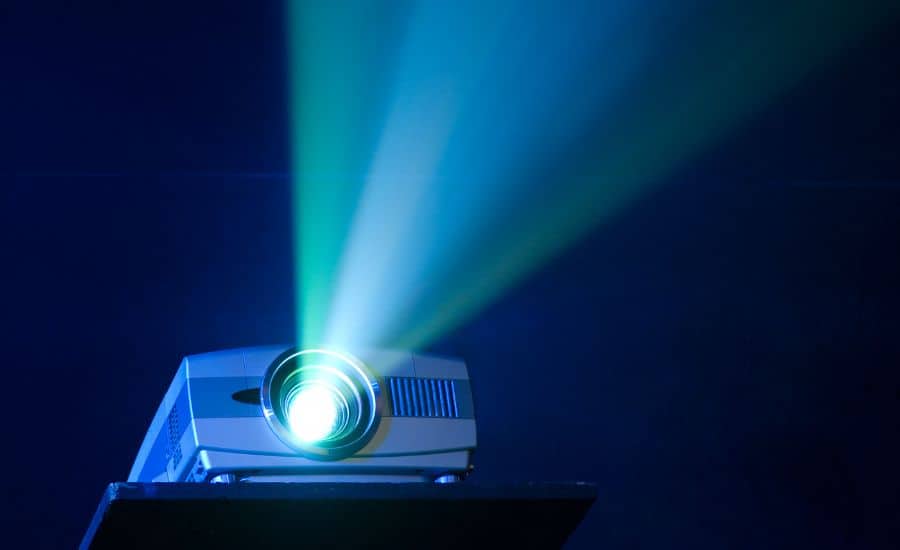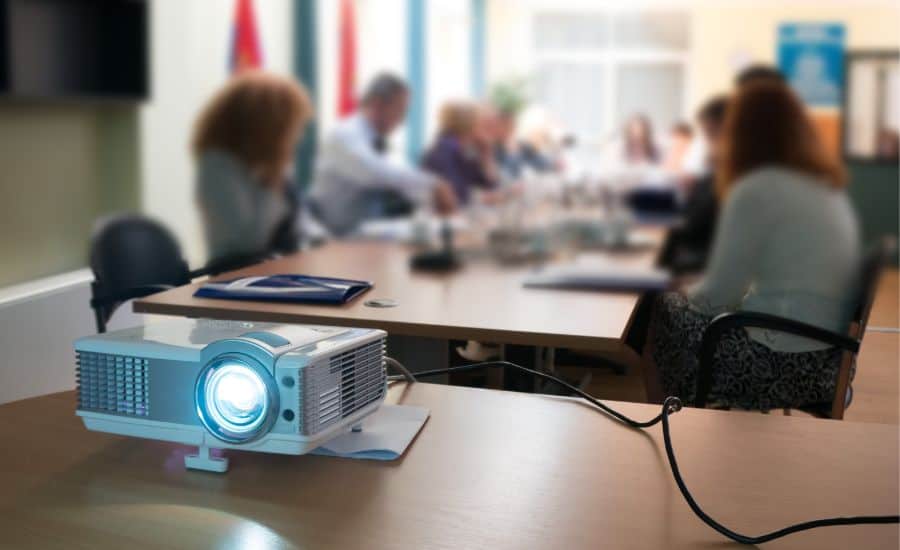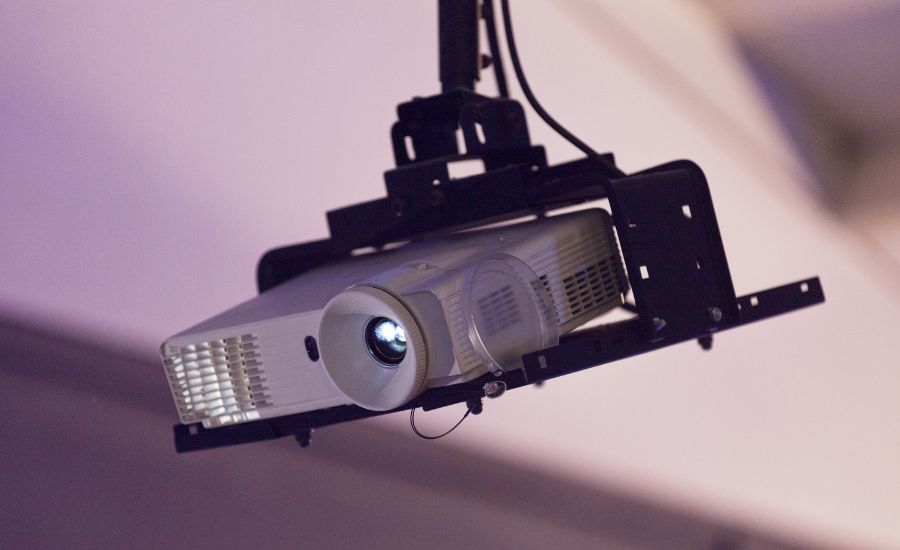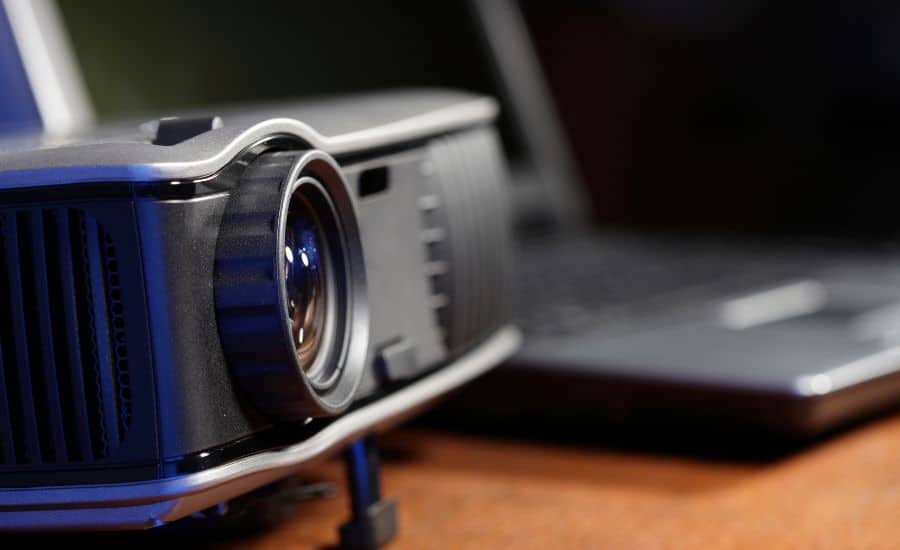Projectors are a popular choice for home cinemas, conference rooms, classrooms, and applications that require large-screen projections. The power consumption of projectors is a common source of concern: How many watts are used?
Lots of people are curious about how many watts does a projector use and if it is more power-saving than other display technologies, such as televisions.
In this context, it’s critical to understand the aspects that determine a projector’s power consumption and how many watts are used, such as projector brightness, the type of bulb or light source used, and the features and settings enabled on the device.

In this piece, we will look more closely at projector power consumption and present some instances of how many watts does a projector use.
Types of projectors
There is an assortment of projectors on the market, each with a set of characteristics and power consumption levels, so it’s preferable to have an idea of how many watts each of them uses.
Here are some examples of different categories of projectors and their typical wattage.
Home theater projectors
Designed for use in home theaters, these projectors typically utilize 100 to 400 watts of power.
The Epson Home Cinema 1060, for example, requires approximately 315 watts of power.

Business projectors
These are intended for use in meeting rooms, classrooms, and other professional environments. How many watts they use? They usually need between 200 and 500 watts per hour of power.
For example, the Epson PowerLite 1781W uses approximately 300 watts of power.

LED projectors
LED projectors employ LED light sources. Does this projector consume less energy than standard bulb-based projectors? Yes, it does. How many watts they use? LED projectors usually draw less than 100 watts of power.
The Anker Nebula Capsule, for example, uses about 15 watts of electricity.
Laser projectors employ laser light sources, which are more energy-efficient than LED projectors. They usually need between 100 and 500 watts per hour of power.
The LG HU85LA, for example, employs a laser light source and requires approximately 320 watts of power consumption.

DLP projectors
They generate images by combining a DLP chip with a lamp life or LED light source of a projector bulb.
DLP projectors have strong contrast ratios and great color accuracy.
DLP projectors can require anywhere from 100 to 800 watts of power, in line with the size and brightness of the projector.
A compact, portable DLP projector built for home use, such as the Optoma ML750ST, may require roughly 50 watts of power, whereas a bigger, commercial-grade DLP projector, such as the BenQ SU931, may use up to 800 watts of electricity.
Some modern projectors, like DLP projectors, employ LED light sources, which are more energy-saving than classic bulb-based projectors.
It is important to note that these are only estimates, and the electricity consumption of different projectors might vary depending on a variety of parameters, such as brightness settings and functions enabled on the device.
It’s usually a good idea to look over a projector’s power specifications to obtain an accurate comprehension of its energy uptake.

FAQ
Do projectors use a lot of power?
The power consumption of projectors can alter in keeping with numerous aspects, such as the level of brightness of the projector, the type of bulb or lamp used, and the features and settings enabled on the average projector bulb.
Projectors meant for home usage or small conference rooms typically consume 100 to 400 watts of power-led projector use.
However, larger commercial projectors used in theaters, auditoriums, or large conference rooms might consume 500 to 1500 watts of power.
It’s worth noting that the projector’s power consumption has dropped in recent years as a result of the development of more energy-efficient projector bulbs like halogen bulbs, LED bulbs, and technologies like LED and laser projectors.
The contemporary projector can use far less power projector bulb or electricity than the classic light bulb-based projectors while still producing high-quality images.
The small projector uses only about 25 watts of power. Actual figures may differ. They are nevertheless quite power-efficient.
For projection in small settings, the micro projector works effectively. For proper image quality, high-resolution devices and tiny lenses are required.
When it comes to projecting in a bigger location, tiny projectors with a capacity of 100 watts will suffice.
They are still highly power efficient, yet provide enough illumination to cover a relatively broad area.
If you are concerned about the electricity usage, it is worthwhile to review the specs of the specific projector, like the LED projector you are considering purchasing or using, as well as compare its power consumption to that of other models, to make an informed decision.
Furthermore, certain projectors may offer power-saving features or settings that can help reduce energy use.
How many watts does an Epson projector use?
Epson electricity usage varies in line with the model and specs of battery-powered projectors, like LED projectors.
As an example, below are some predicted average power consumption estimates for a few common Epson projector models.
Epson Home Cinema 1060
This model is intended for home usage and requires approximately 315 watts of a battery-powered projector.
Epson PowerLite 1781W
This is a small and portable projector projection technology designed for business or education. When in use, it consumes approximately 300 watts of the battery-powered projector.
The Epson Pro L12000QNL
This is a high-end commercial projector projection technology suited for large settings like theaters and auditoriums. Its power usage is predicted to be roughly 1450 watts for the battery-powered projector.
It should be noted that these are only estimates, and the actual power consumption of a certain Epson projector projection technology may vary based on factors such as brightness settings, bulb types, like light bulb type, and usage habits.
It’s usually a good idea to look over a model’s specifications to obtain an accurate picture of its power consumption.
Does a mini projector use a lot of electricity?
A mini projector’s power consumption varies based on the model and its features, but in general, mini projectors require less power than larger, full-sized projectors.
LED light sources are used in some tiny projectors, which are more energy-efficient than classic bulb-based projectors.
Some popular small projectors on the market, for example, utilize the following amounts of power:
Anker Nebula Capsule: When in operation, this small projector requires approximately 15 watts of power.
LG PH550: When in use, this tiny projector requires around 60 watts of power.
AAXA P300: When in use, this tiny projector consumes around 25 watts of power.
It’s important to note that these are only estimates, and the real power consumption of a certain tiny projector may vary depending on factors like brightness settings and usage habits.
Mini projectors, on the other hand, are often built to be more power-saving and require less power than larger projectors.
Does a projector use more electricity than a TV?
The power consumption of projectors and televisions can vary depending on several factors, including the device’s size and features, the technology employed, and the brightness or picture settings.
In general, projectors consume more power than TVs of the same size and specs. This is because projectors require a light source to project an image onto a screen or wall, which can consume a lot of energy.
A normal 55-inch LED TV, for example, may consume 60-120 watts of electricity, whereas a projector with comparable brightness characteristics may consume 150-400 watts of power.
It should be noted, however, that the power consumption of both devices can vary greatly based on their features and usage patterns.
Furthermore, modern technologies like LED and laser projectors can be far more energy-efficient than older bulb-based projectors.
Finally, the easiest approach to evaluate the power consumption of a projector vs a TV is to examine the specifications of the individual models you’re interested in.
Is it true that all projectors use the same amount of power?
Thousands of projectors, like TVs, LED projectors, and LCD projectors, are currently available on the market.
Their prices range from as little as $50 to as much as $10,000.
Furthermore, the power consumption of various projectors, like LED projections, is affected by the use of different projection and light technology.
As a result, the power consumption of a projector, like an LED projector, is not uniform over the range and fluctuates greatly. It is determined by the projector’s characteristics, projection technology, and lighting technology.
How do you determine the power consumption of a projector?
The data presented above merely represent the average power use that the projector consumes.
To precisely calculate the projector’s power and the electrical bill, you need to utilize professional measuring techniques or tools.
Using an electricity-powered screen is one of the simplest ways to determine a projector’s wattage. This device will measure and report the amount of power consumed by the projector.
It is not difficult to use an electric screen. Connect one end of the measurement instrument to the power supply and the other end to the projector.
When you switch on the projector, depending on how much power consumed, the power usage monitor measures and calculates the wattage.
You may have a rough notion of the power consumed by various types of projectors up to this point. However, it might vary greatly between projectors and their usage.
In addition, to scale down the power consumption of a projector, operate it in low-power or Eco mode, ensure it has an automatic idling option, use lower brightness, disable unneeded features, and switch it off when not in use.
How to calculate an electrical bill?
You will need to know your electricity usage in kilowatt-hours (kWh) and your electricity rate to calculate your electric bill in line with how many watts does a projector use.
Determine your electricity usage: Your monthly electricity bill will show your electricity usage on the basis of how many watts does a projector use. Look for the area that displays your use in kilowatt-hours (kWh).
If you don’t have a bill, you can estimate your usage by observing the wattage of each gadget and the amount of time it is used each day. To calculate the usage in kilowatt-hours, divide the total wattage of lamp life by 1,000.
Determine your electricity rate by doing the following: The cost per kilowatt-hour of power is your electricity rate. Your rate can be found on your monthly electricity bill, depending on how much power you used.
If you don’t have a bill, you can find the current rate by contacting your electrical provider or visiting their website.
Determine your electricity bill: Multiply your kWh consumption by your electricity rate depending on how much power you used.
For example, if you use 500 kWh and your rate is $0.15 per kWh, your electricity bill will be $500 x $0.15 = $75.
The projector can be used with an inverter. However, before using this method, you should check the wattage and amperage of the projector.
It’s also worth noting that your electricity statement, depending on how much power was consumed, may include other fees and levies such as taxes, delivery costs, and service fees.
These fees vary according to your area and electricity provider, and how much power you used.
Conclusion
Projector power consumption varies greatly based on numerous parameters, such as model, type of light source utilized, and brightness settings.
While bigger commercial projectors and battery-powered projectors can require substantially more power than smaller home projector use, the current projectors have dropped over the years as more power-efficient technologies, such as LED and laser projectors have been developed.
When shopping for a projector, it’s usually a good idea to read the specifications of the type you’re considering to get an accurate understanding of its power usage.
Using power-saving features and settings can also help minimize the amount of electricity consumed by a projector, making it a more environmentally friendly and cost-effective alternative for your home or company.
